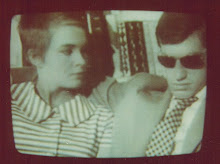Doug Pray's film highlights the evolution of the advertising industry in the last fifty years. Since the MadMen series has brought the early world of ads to our collective attention in the last couple years, it's hard to deny the impact of these these words and pictures on the culture. When I was a college art major in the early 1970s, "commercial art" was viewed as low art...a world apart from fine arts and crafts. Art for the purpose of selling was suspect. I enjoyed learning more about this a few ago by watching the documenary about graphic artist, Milton Glaser (http://prettygoodmovie.blogspot.com/2010/02/milton-glaser-art-is-work-2009.html).
Our 21st century world is filtered through a web of marketing that we have come to accept as the air we breathe. The average America child is exposed to about 20,000 television commercials each year. This film opens as a young man named Chad, goes to work for his family business of "Rotators." The work entails rotating and installing new billboard ads. He claims that three generations of his family have thrived doing this work and there is never a shortage of work to be done with 450,000 billboards in the US.
During the 1960s ad agency Doyle, Dane, Bernbach began allowing the art director and copy writer to join forces to create the ads that were previously conceived by the less creative business types. The film features all the memorable commercials through the decades. Phyllis Robinson was DDB's copywriter responsible for recognizing the "Me Generation" and creating Clairol's tagline "It lets me be me." A gray-haired woman at the time of the film interview, she admits that she never once colored her own hair.
George Lois, a tough-talking guy from the Bronx is all sales and known for his in-your-face celebrity campaigns, such as "I want my Maypo," spoken by Mickey Mantle and other sports figures. Lois claims that "advertising should be subversive." He later converted the Maypo formula to "I want my MTV" using Mick Jagger and other rock stars. He was also responsible for numerous engaging Esquire Magazine covers, such as a face with parts of Malcolm X, John Kennedy, Bob Dylan and Fidel Castro. A visionary who convinced unknown clothing designer, Tommy Hilfiger that he could make him famous overnight with a billboard that listed the top four desgners for men--Ralph Lauren, Pierre Cardin, Calvin Klein, Tommy Hilfiger. Despite Hilfiger's embarrassment and worry that it could kill the future fo his business, agreed and he did become wildly successful almost overnight.
Mary Wells, of Wells, Rich, Greene is interviewed in her envionment of tasteful rows of flower vases and pottery. We notice a note on the desk that reads "Why not have a bigger life?" She explains how her theatrical bent gave her just the right attitude to create memorable ad campaigns, such as the one for Braniff International Airlines, featuring planes painted all different colors and stewardess uniforms designed by Pucci to match the color-scheme of each plane.
Hal Riney claims to have been a quiet kid who longed for a different kind of family. He is known for a series of television ads during the 80s that relied on heartfelt scenes of family life and the american dream with authoritative narrative. He launched Perrier and created the Presidential campaign ad for Ronald Reagan "It's morning again in America."
Goodby, Silverstein & Partner aim for "brutal simplicity" with a motto "art serving capitalism." With Haiku-like slogans such as the "Got Milk" campaign, they often created a kind of mass happening appeal, an inclusive approach to the audience. "We're trying to entertain society using client's products," says Goodby.
Lee Clow is a surfer with a rebel spirit who believes the creative people should be in charge. At TBWA/ChiatDay he helped create the "Think Different" 1984 superbowl commercial that introduced the Apple Macintosh computer and later introduced the dancing black sillouette iPod ads that remains one of my personal favorites. "When done well, an ad can be part of culture instead of pollution," Clow says. "All brands will become media--everyone can become their own network."
Wieden & Kennedy used the words of a man about to die on death row--"Let's do it"--and transformed the words to Nike's famous slogan of the late 1980s. "Just do it" is attributed to offering people a life-changing message that may have sparked divorces, weight-loss, better fitness, career change and other acts of self-improvement. Another Nike campaign--"if you let me play sports"--suggests a host of better life outcomes for girls who play sports.
Many more campaigns are featured in this film that delves into the hearts and minds of the people who create them. Advertising is here to stay. It has become an artform of our culture worth appreciating.
11/7/10
Subscribe to:
Post Comments (Atom)





No comments:
Post a Comment